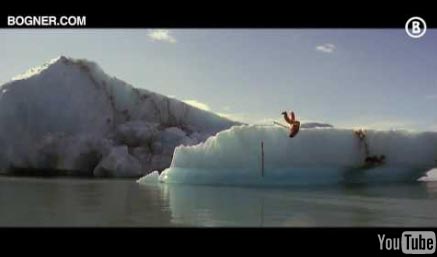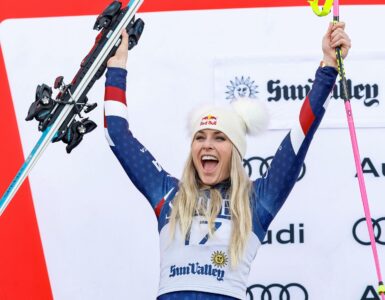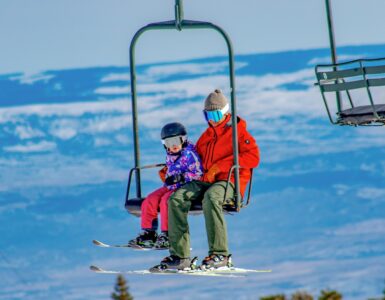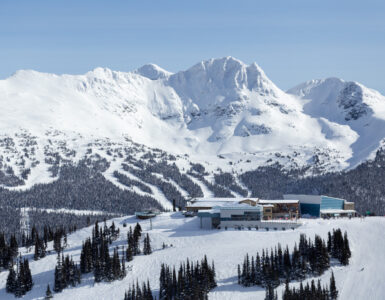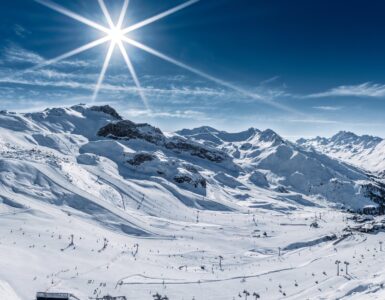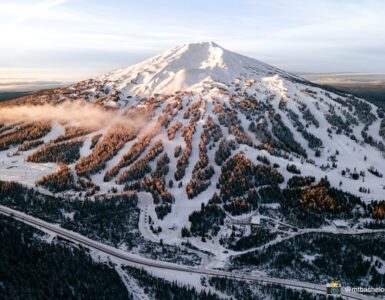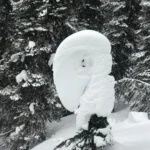You remember the scene: James Bond was only a blur as he evaded the villains by skiing at nearly 70 miles per hour down the iced, lightning fast, bob track in the 1981 film For Your Eyes Only: The famous 007 spy hero, always shrewdly clever in dodging his enemies, spared no style points in the bullet-fast luge pursuit. This perhaps most infamous of ski stunts was staged with meticulous preparation, and on film, it went as smoothly as a hockey puck glides on freshly Zambonied ice.
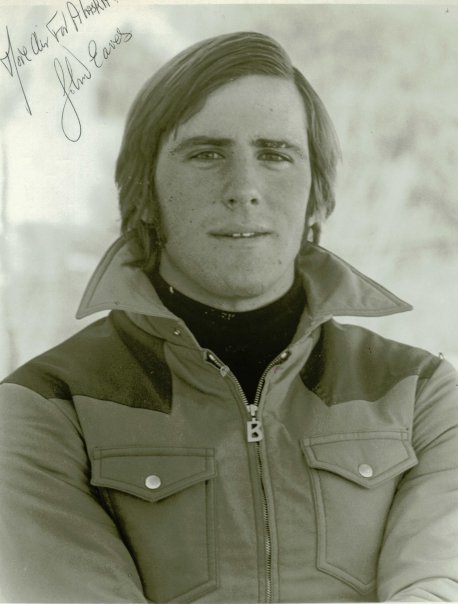
Filmed in Cortina, Italy, the scene, in which Eaves doubles for Roger Moore, shows him carrying so much speed through the bob run that when he hits the curves his body is completely horizontal. And if this isn’t dangerous enough, he was in hot pursuit of a speeding bobsled while simultaneously being chased by an angry guy on a motorcycle.
“We did a lot of takes and they were difficult,” Eaves recalls. “We worked on it for three weeks doing various different angles and shots. I was kind of sandwiched by two madmen and it was fast.”

And, as if his own mach speed wasn’t enough, he was at times aided by a little movie magic — being pulled by the sled with piano wire.
At the height of his competitive freestyle skiing career, from 1977 to 1981, Eaves won six world titles for Canada, three in combined freestyle and three in his specialty: aerials. His stunt work in the James Bond films grew out of a relationship with German ski filmmaker and clothing mogul Willie Bogner.
Eaves is now going on 25 years of sponsorship with Bogner, giving new meaning to the term “freeskiing.” At 45, Eaves was the oldest sponsored athlete at the 1999 Canadian Freeskiing Championships. Rather than sit on a judge’s panel, he figured he’d rather ski.
“I was judging last year in Chamonix with a friend of mine from Alberta…We were at the event and said, ‘well, we could probably do that ourselves instead of judging next year.’ It’s a little more fun, you know.” So in January 1999, Eaves was down with the kids at Blackcomb Mountain, British Columbia. He skied the chutes and cliffs with some green, some accomplished, yet all extremely talented, younger skiers, including ’99 champion Jeff Holden, Alaska guide Dean Cummings, last year’s World Extremes champion Arnaud Adam, and last year’s overall champion Shane McConkey.
“Shane’s father was a hero for me — Diamond Jim. He’s a legend around the Whistler area. My mother used to ski with him. He was kind of the freerider of the ’60s. I guess that obviously rubbed off on Shane,” Eaves said. McConkey was equally aware of Eaves’ reputation prior to their working together on a Bogner IMAX movie last year, also in British Columbia. During that shoot, McConkey got to witness first-hand Eaves’ keen technique. “He was doing shit that I wouldn’t do and he was 44 at the time,” said McConkey. “He would jump into these crevasses and land on the other side. He was like, ‘look, it’s not that hard,’ and I was like, ‘then you do it.'” And what did McConkey learn? “I learned I can still huck my meat at 44.”
Eaves enjoys the technical aspects of skiing glaciers and seracs during a time when the freeskiing trend seems to be one of fast and steep, big mountain descents. During the filming of the IMAX movie, Eaves said, he and McConkey worked in terrain where few experts, regardless of age, would feel comfortable.
“I was kind of sandwiched in between two madmen and it was fast…”— John Eaves
“We got into all these seracs,” he explained, “and basically that’s where I’m at home, where these extreme guys are not so much at home is working in, I guess, extreme hazardous serac areas where there are crevasses, where you’ve got to probe to find out where the bridges are strong so you know where you can ski without going through a hole.”
In order to ski some of the extreme locations he’s called to, Eaves has had to go so far as having special edges made. Required to ski icebergs in Iceland for the film White Magic, he needed special “gripping” sawtooth edges (made in a metal tool and diecutting shop where they peeled back the P-tex and cut teeth into the edges). At first he skied the ice while belayed from the rear of his climbing harness. As the rope was let out, he descended. He lost the rope for the shoot.
Eaves vividly remembers skiing those 50 degree faces of 200 to 300 foot ice. “That was pretty wild because the skis really worked. I was really amazed at how well they gripped but still allowed me to move forward.” Using 205cm slaloms, Eaves thinks he would go shorter now. “Shorter is probably better. I would probably do it on 190s now if I did it,” he said.
Due to these types of experiences, Eaves’ comfort zone sits somewhere on the outskirts of most people’s, though, as illustrated by the conditions at this year’s Canadian Freeskiing Championships, in which his approach was cautious, he does recognize his limits.
On the first day of the competition, Eaves said, conditions were “about the scariest I’ve ever skied, that’s why I just did the simplest line.” But there was no lack of airtime by competitors and while most stuck the landings, those who didn’t were lucky and didn’t get hurt. Checking out the bold lines of the younger skiers, who were hungry for large launches, Eaves says he saw some promising talent and also was reminded of his own earlier experiences, when, in the ’70s, freestyle skiers were also pushing the limits.
“While I was at the height of my career, aerials were the dangerous ones, where people could get paralyzed or killed or something, and we had that happen, and we were shut down by the insurance companies in America… I think that if the governing bodies make smart moves and people don’t hurt themselves, I think the sport will go quite a ways,” he said.
“I was judging last year in Chamonix with a friend of mine … we said, ‘well, we could probably do that ourselves instead of judging next year.’ It’s a little more fun, you know…”— John Eaves
Eaves has been motivated by heroes such as the great Olympian Stein Erikson, Hermann “Jackrabbit” Smith-Johanssen, Herman Goellner of the film The Mobius Flip, Willie Bogner (who also skied the bobsled run… and filmed it) and freestyle pioneer Wayne Wong.
“I used to mount skis in a ski shop in Montreal and there was a picture of Wayne above me,” Eaves recalls. “I was like, ‘God, I’ve got to go meet this guy and learn how to ski.’ Then I got a job operating the lifts in Whistler (in 1972 at the summer ski camp) … so he was one of the guys who really just said, ‘hey, I like what you’re doing, I’m going to help you out.'”
Going on to dominate freestyle skiing as it emerged in the late ’70s, Eaves also competed in ski ballet, though he confesses he’s a tad embarrassed to admit it. A talented musician, he choreographed his own routines.
While Eaves certainly knows about risk, he’s also a pro. Although pointing two planks down a luge run for James Bond notoriety may seem like reckless abandon, even then Eaves was in control.
“If I had to slow down fast, you couldn’t do a snow plow, but you could do a quarter of a snow plow and really angle your edges in. Then at the same time I would reach around with my pole behind my ankle and auger into the ice like a brake and that would help me slow down.”
Now he thinks a little bobsled training wouldn’t hurt, especially in cases like this season’s hundredth of a second tie between World Cup champions Lasse Kjus and Hermann Maier.
“I always thought it’d be a great thing for downhill racers to train in a bobsled run. It just builds up your quads like crazy and also gives you very good sense of control on ice.” The ultimate question, though, and one which Eaves is certainly qualified to answer…who’s the better Bond?
Put simply, “Sean Connery never skied.”
— Michelle Quigley, Mountain Zone Staff


